Abstract
Two prototype moss-based green roof systems were developed and evaluated using a newly cultivated strain of Racomitrium japonicum (Dozy & Molk.) to investigate their feasibility in mitigating rooftop heat and enhancing carbon sequestration under actual urban conditions. Flat and sloped-type green roof systems (2 m × 2 m each) were developed and installed on a rooftop to investigate their performance in summer (from June to August 2025). The moss-based systems reduced rooftop surface temperature by an average of 6–10 °C during daytime and retained approximately 1.5–2.5 °C of heat at night, thereby contributing to cooling and thermal buffering. The moss layer effectively reduced solar radiation heating of the underlying soil. Despite exposure to intense sunlight and high summer temperatures, the moss maintained a consistent growth rate of 3–5 mm per month. The annual carbon sequestration capacity of the prototype system was estimated at approximately 0.3 kg C/m2.year, which is comparable to values reported for other vegetation types. These findings indicate that moss-based green roofs incorporating the newly cultivated moss strain have practical potential for urban heat island mitigation and carbon capture.
1. Introduction
Urbanization has generally altered local climate systems through the urban heat island effect, raising surface and air temperatures in cities relative to surrounding rural areas. Localized warming intensifies the energy demand for cooling, elevates greenhouse gas emissions, and exacerbates heat-related health risks during extreme weather events [,,]. Because global warming is worsening and cities are growing denser, leading to higher temperatures in urban areas, low-energy cooling solutions that can be integrated into buildings to reduce the heat island effect are required.
Green roofs have been widely adopted as nature-based solutions to mitigate the heat island effect and deliver additional benefits, including stormwater retention, runoff delay, improved water quality, noise reduction, and habitat creation []. However, the vegetation of green roofs determines their performance and maintenance costs. Broadleaf plants are seasonal, whereas conifers are difficult to maintain. Sedum-based green roofs are a potential solution that is drought-tolerant but has limitations in terms of biodiversity support and aesthetic variability. Moreover, sedum-based roofs experience heat stress, seasonal dieback, and limited cooling performance during peak summer conditions [].
Mosses are a promising alternative vegetation type for green roofs. As non-vascular bryophytes, mosses have unique physiological traits that enable them to withstand repeated desiccation and rehydration cycles, making them highly resilient to drought and temperature extremes [,]. Table 1 summarizes the studies of the feasibility and advantages of moss-based green roofs.

Table 1.
Studies of moss-based green roofs.
As shown in Table 1, mosses are a viable and effective vegetation type for extensive green roofs, particularly where the substrate depth and structural load are limiting factors. Species such as R. japonicum and P. commune have shown strong survival and coverage under rooftop stressors, including drought, thus confirming their suitability for low-maintenance systems []. They can thrive on extremely thin substrates, significantly reducing the structural load and allowing deployment on lightweight roofs where conventional vegetation may be infeasible []. Moss layers can reduce the substrate temperature, providing passive cooling comparable to that of vascular plant systems [,]. In addition to thermal regulation, moss-based green roofs provide ecosystem services. Their mat structure can absorb and retain precipitation, improving stormwater management even on roofs with minimal substrate depths []. Mosses also contribute to biodiversity support; sedum–moss roofs host various invertebrate species, including moth larval stages, thereby expanding the ecological value of green infrastructure []. Moreover, mosses play a key role in the global carbon cycle by collectively storing an estimated 6.43 Gt of carbon worldwide and by contributing significantly to CO2 sequestration []. Newly developed moss species for potential green roof applications were investigated and found that they maintained high CO2 capture rates, even under elevated temperatures and strong light intensity. This finding addresses a key limitation of most mosses, which are generally shade-adapted and, therefore, less commonly used as the sole vegetation type on roofs exposed to intense sunlight [].
In addition, mosses provide unique air quality benefits. Their high surface areas and leaf micromorphologies make them efficient at capturing fine and ultrafine particles. Recent field tests of the MosSkin moss panel system in traffic-impacted areas have reported capture rates of up to 45,000 particles per mm2, with nearly half of the collected fraction below 0.5 µm []. Moss systems can also remove volatile organic compounds such as toluene and significantly reduce formaldehyde concentrations when sufficient biomass is used []. Furthermore, mosses play a biogeochemical role in methane mitigation. Sphagnum species provide a habitat for methane-oxidizing bacteria within their hyaline cells, enabling in situ CH4 oxidation before it escapes into the atmosphere []. Laboratory mesocosm studies showed that submerged Sphagnum layers could reduce methane emissions from peat systems by up to 93%, acting as a natural biofilter and simultaneously benefiting from methane-oxidizing bacteria-generated CO2 for photosynthesis []. This microbial association highlights the potential for integrating moss roofs into climate mitigation strategies beyond CO2 sequestration.
The harvested moss biomass has potential applications beyond environmental services [,]. Mosses such as Physcomitrella patens have been successfully engineered to produce recombinant proteins (e.g., human complement factor H and erythropoietin), vaccine antigens, and secondary metabolites. These include taxadiene (a paclitaxel precursor), artemisinin (an antimalarial drug), and fragrance terpenoids such as patchoulol and sclareol []. Compared with conventional plant or microbial systems, moss-based production allows for human-like glycosylation patterns, improved batch-to-batch consistency, and a reduced risk of contamination. Photobioreactor technologies support bench-to-pilot-scale cultivation and provide a path toward industrial-scale biomass production. Mosses show potential in pharmaceuticals, cosmetics, agriculture, and bioremediation applications (e.g., heavy metal uptake), suggesting their promise for moss-derived products in sustainable bio-based industries [].
In particular, moss-based green roofs support fewer arthropods than systems planted with other vascular species []. This relatively simple community structure could be advantageous in minimizing allergen sources, pest colonization, and ecosystem maintenance requirements in urban environments.
In addition to their resilience and low-maintenance requirements, mosses have unique industrial advantages in green roof applications. As they can be precultivated off-site in modular mats or panels, moss systems enable rapid on-site installation and minimize long-term maintenance requirements. This prefabrication approach, such as the MosSkin system [], also facilitates quality control, scalability, and easier retrofitting of existing buildings, supporting the widespread commercialization and urban integration of moss-based green roofs.
Despite these advantages, research on moss-only roof systems remains limited, with most studies focusing on community ecology or thermal and hydrological performances under experimental conditions. However, there is little evidence on how moss systems perform across different roof geometries or how they can be engineered for large-scale deployment.
In our previous study, a new moss (a selectively bred strain of R. japonicum (Dozy & Molk.), designated Parkortanso No. 1) demonstrated strong potential for green roof applications as it maintained healthy growth and physiological activity under high light intensity and elevated temperature conditions in controlled laboratory tests []. Based on previous findings and the water retention and evaporative characteristics of mosses, we hypothesized that the moss layer would substantially reduce the rooftop surface temperatures through evaporative cooling during the day and provide thermal insulation at night. Furthermore, the flat and sloped moss-based systems were expected to show comparable cooling efficiencies, with only minor differences attributable to structural exposure. The newly developed moss was also expected to exhibit measurable carbon sequestration comparable to that of other low-biomass vegetated systems. These hypotheses collectively addressed the potential of moss-based green roofs as an effective, lightweight, and sustainable strategy for mitigating the effects of urban heat islands and contributing to urban carbon management. Accordingly, this study aimed to investigate the practical feasibility and environmental performance of the new moss when applied to green roof systems under actual rooftop conditions. Two moss-based green roof prototypes were developed: a flat system optimized for conventional flat roofs and a sloped system designed for pitched roofs coupled with a new moss. The investigation focused on three key aspects: the effectiveness of moss-based roofs in mitigating rooftop temperatures under high summer heat, the influence of roof geometry (flat vs. sloped systems) on thermal regulation, and the potential annual carbon sequestration of the moss when applied to real field installations.
2. Materials and Methods
2.1. Climate Conditions of the Study Location
Seoul, South Korea, is located in a mid-latitude temperate climate zone with four distinct seasons. Spring (March–May) and fall (September–November) are typically clear and dry under the influence of migratory anticyclones, whereas summer (June–August) is characterized by hot and humid conditions dominated by the North Pacific high-pressure system. In contrast, winter (December–February) is cold and dry due to the prevailing continental anticyclone. The average annual temperature is 13.2 °C. The highest average temperature is 27.3 °C in July, and the lowest average temperature is −2.8 °C in December. The annual average precipitation is 1775.3 mm. The least and most rainfall are recorded in February and August, respectively. The relative humidity varies from 55% to 75% [,].
2.2. Experimental Materials
Parkortanso No. 1, a newly cultivated strain of Racomitrium japonicum (Dozy & Molk.), was used in this study. The moss was developed by Parkor Bio & Green Co., Ltd. (Seoul, Republic of Korea). Wild individuals of R. japonicum (Dozy & Molk.) were collected from multiple natural habitats across different regions to identify those most suitable for rooftop applications when exposed to strong sunlight and high temperatures. The collected specimens were cultivated outdoors under natural environmental conditions in South Korea for five years to evaluate their growth rate, morphological stability, and environmental adaptability. Individuals exhibiting the highest growth rate and the strongest tolerance to heat and light stress were selectively propagated through vegetative multiplication to ensure genetic uniformity. This superior strain was characterized based on its morphological features and subsequently registered as intellectual property under the name Parkortanso No. 1. This process demonstrates a selective breeding and domestication approach for developing a cultivated strain of R. japonicum (Dozy & Molk.) optimized for green roofs and urban temperature mitigation applications. The cultivated strain of R. japonicum (Dozy & Molk.) was inspected and certified by the Korea National Forest Seed Variety Center. A quantitative statistical comparison between the Parkortanso No. 1 moss and the original wild R. japonicum obtained from the inspection process is presented in Table S1 (Supplementary Materials).
2.3. Experimental Procedure
The experiment was conducted in two phases: an initial phase using bare mosses without irrigation and maintenance, and a second phase with a developed prototype moss-based green roof that included an irrigation system for practical application.
2.3.1. Initial Phase: Investigation of Rooftop Application Feasibility of the Bared Moss
The newly cultivated moss survived well under high temperatures (35 °C) and strong light intensity (1500 µmol/m2.s) in the laboratory chamber experiments []. However, rooftop environments differ significantly from laboratory conditions and can be particularly harsh for shade-loving species such as mosses. Therefore, a preliminary study was conducted to examine the effects of rooftop weather conditions on the new moss.
Several factory moss trays were placed on the rooftop of a five-story university building in Seoul. The rooftop was uncovered, without shading vegetation, and was fully exposed to direct sunlight throughout the day. Because mosses lack true roots and developed vascular systems, they have limited access to water and soil nutrients through their roots []. Instead, they absorb water and nutrients from atmospheric deposition, such as rainwater, dust, and humidity, through their leaves and surfaces []. Therefore, moss trays were left to grow naturally without supplemental support (e.g., water or nutrient) to evaluate their inherent survival capacity. The experiment was conducted over one year to assess seasonal effects. All observations were recorded and considered during the development of a prototype system for moss-based green roofs.
2.3.2. Second Phase: Investigation of Rooftop Application Feasibility of the Prototype Moss-Based Green Roof
- (a)
- Development of prototype moss-based green roofs
Two prototype moss-based green roof systems were developed to evaluate the practical feasibility of the newly cultivated moss. One prototype was designed for a flat roof (hereafter referred to as the flat-type system) and the other was designed for a pitched roof (the sloped-type system; Figure 1). Each system measured 2 m × 2 m. The slope angle is 15°. Most Korean low-rise residential buildings use roof angles between 10° and 20°, whereas steeper angles (30–45°) are mainly used for aesthetic purposes or to accommodate snow loads []. Moreover, an extensive green roof achieves maximum stormwater retention (~85%) at a slope of 1°, which decreased to 76.4% at 14° []. Considering the balance among the typical Korean roof architecture, stormwater retention performance, and substrate shear stability, a slope angle of 15° was selected for the sloped prototype.
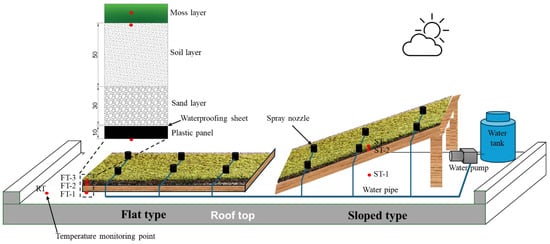
Figure 1.
Experimental set-up for moss-based green roof.
Both systems were installed on the same rooftop of the five-story university building used in the preliminary experiment. The experiment was conducted between May 2025 and September 2025. Because moss is vulnerable to direct and intense sunlight, the experiment was conducted during summer to assess the performance of moss-based green roofs under the most challenging conditions.
The system comprised four main layers arranged from bottom to top: a 10 mm plastic panel, a 30 mm sand layer for drainage, a 50 mm composite soil layer for moss growth, and a moss layer. The boundaries of the system were constructed using wooden frames to provide an aesthetic appearance. All the components were supplied and assembled by a professional moss company. Parkortanso No. 1 was used for the experiments.
The sand layer was designed to ensure efficient drainage and minimize damage from heated water during midday. A waterproof sheet was applied to protect the structure. Several herbaceous flowers were added for decoration. Based on the results of the preliminary experiment, a 20 × 20 mm mesh net was placed over the moss surface to protect it from wind damage and disturbance by wild animals (Figure 2).
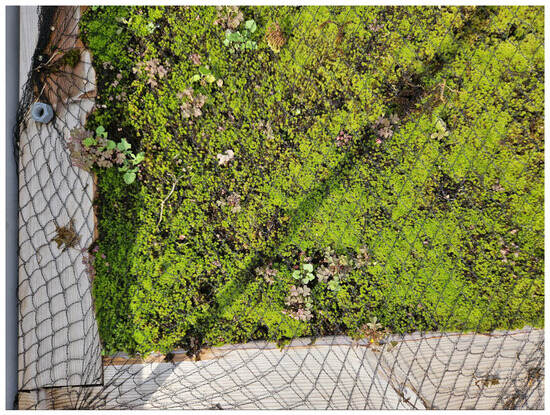
Figure 2.
Mosses covered by a protection net.
Although mosses can survive by tolerating desiccation and quickly rehydrating when water becomes available [], a lack of water can reduce their carbon sequestration []. Based on the results of the initial phase, although mosses could survive without an irrigation system, they remained under persistently dry conditions with a dark green color. This resulted in low rates of carbon sequestration []. Accordingly, a semi-automatic irrigation system was installed to provide water to the green roof. The system comprised a 250 L water tank, a water pump, spray nozzles, and an automatic control unit. The spray nozzle is a micro-sprinkler (Vibronet, Oriba, Giv’atayim, Israel) with a flow rate of 40 L/h and a maximum effective coverage area of 2–3 m. Five nozzles were evenly distributed across each type of green roof system. Based on preliminary experimental results, the moss was irrigated twice daily for 15 min at 05:00 and 18:00 to maintain adequate moisture and reduce the risk of thermal damage from heated water during sunlight exposure. The total amount of water for each green roof prototype was approximately 50 L/event. Although mosses have high water content, they lose surface water rapidly through exponential decay within the first few hours of exposure, particularly under warm, dry, or windy conditions []. Photosynthetic activity in mosses follows a hump-shaped response to hydration, with optimal photosynthesis occurring at intermediate water content (typically 200–1000% dry weight) []. Accordingly, early-morning irrigation may effectively rehydrate moss tissues before sunrise, enabling them to store sufficient water for evaporative cooling at midday as temperatures rise, whereas evening irrigation restores hydration after daytime desiccation and sustains metabolic recovery overnight. However, the irrigation volume was controlled to supply only the necessary amount of water to avoid excessive water, which could enhance physical cooling through the direct evaporation of water.
As described earlier, because supplemental fertilizers are unnecessary for moss growth [], only water was used in this study. This study also provided an opportunity to evaluate the necessity of fertilizer supplementation in moss-based green roof systems.
During the first month, the prototype system was covered with black nets to provide shade. As with other vegetation, mosses require an acclimation period after transportation and construction processes. This shading, producing a familiar habitat for mosses, helped the mosses adapt more quickly to the new environment and recover from damage incurred during installation. Such acclimation was also recommended in other studies [,].
- (b)
- Investigation of the performance of a prototype moss-based green roof
To assess the performance of the prototype moss-based green roof, temperature variations, moss growth rates, and carbon sequestration rates were measured.
To evaluate the effect of the moss-based green roof on the rooftop temperature, temperature variations were monitored using sensors (88598, Daihan Scientific Co., Ltd., Wonju, South Korea) installed at various points (Figure 1 and Table 2). The sensor accuracy was ±0.3% for reading +1 °C. The logging interval for the sensors was 5 min. Before installation, the sensors were calibrated to ensure consistent measurement results under identical conditions. The sensors were calibrated using standard temperatures by the manufacturer based on the Korea Laboratory Accreditation Scheme. To clarify the difference between sensors’ measurement data and reduce measurement uncertainty, they were placed in the same controlled laboratory environment for 24 h at 25 °C ± 3 °C. Sensor 1 was used as a reference sensor. The measurement data obtained from the other sensors were compared with those obtained from sensor 1. Pairwise correlations were calculated between each sensor and the reference. Linear regression models were derived to correct the systematic offsets or gain differences among sensors to ensure consistent measurements across all sensors. The relative calibration results are listed in Table 3.

Table 2.
Temperature monitoring points for the prototype moss-based green roof.

Table 3.
Correlation equations for temperature sensors used in this study.
Because May was designated as the adaptation period for the moss, temperature monitoring was not conducted during that month. From June to September, the temperatures of the bare roof surface and moss-based green roof were measured to evaluate the performance of the moss-based systems.
In addition, to specifically assess the contribution of the moss layer, the temperatures of the moss layer and the underlying soil were monitored in July, which was selected because it is typically the hottest month of summer (Figure 3). However, the temperature data from June 23 to July 06 and August 10 to August 19 were lost because of electrical supply issues affecting the sensors. Therefore, data from these days were excluded from the analysis.
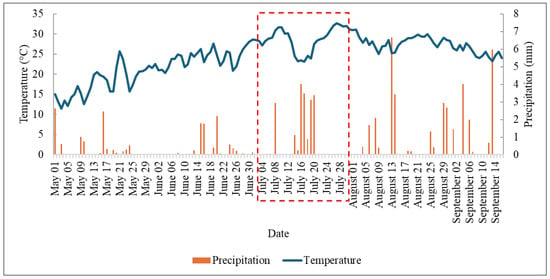
Figure 3.
Atmospheric temperature and precipitation from May to September 2025 in Seoul, South Korea (data taken from [] at Seoul Meteorological Observatory distanced approximately 10 km from the experimental site). The red rectangle indicates the highest temperature month.
The growth rate of the moss was evaluated by measuring its length once a month. Three identical sampling points were designated for each system, and the measurements at each point were repeated five times. The average of three sampling points was used to represent the growth rate of the system.
The carbon sequestration capacity of the system was also determined. After measuring length, moss samples were dried at 65 °C for 48 h to remove all moisture [,]. The dry mass of individual moss bodies was determined using a precision scale (Adventure Pro; Ohaus, Parsippany, NJ, USA). Random mosses with sizes similar to the average measured size were selected for dry mass determination, and the experiment was repeated three times.
To estimate the moss density, the number of moss individuals within an area of 2 × 2 cm2 was counted, and five random points were examined for each system. These values were extrapolated to estimate the total number of mosses per 1 m2. Annual carbon sequestration Cs (g/m2.year) was calculated using Equation (1).
where N is the total estimated number of mosses per 1 m2, MA is the average growth mass of dry moss from May to September (g/month), and CA is the carbon content ratio of the moss adapted from elsewhere (%) [].
The root mean square error (RMSE) was calculated to statistically evaluate the temperature differences, whereas the mean normalized bias (MNB) was used to determine whether the temperatures were systematically overestimated or underestimated. RMSE and MNB were calculated using Equations (2) and (3), respectively:
where T1i and T2i are the temperatures (°C), and n is the number of values.
where Ti is the temperature of subject i, Tsi is the temperature of the standard subject i, and n is the number of values.
All charts were generated in Microsoft Office Excel (Version 2307, Microsoft Corporation, Redmond, WA, USA). T-tests were performed using MATLAB software (Version 9.10.0.1684407, MathWorks, Inc., Natick, MA, USA).
3. Results and Discussion
3.1. Effect of Weather Conditions on Unconstructed Moss in the Initial-Phase Experiment
The seasonal appearance of the moss during winter and summer is shown in Figure 4.
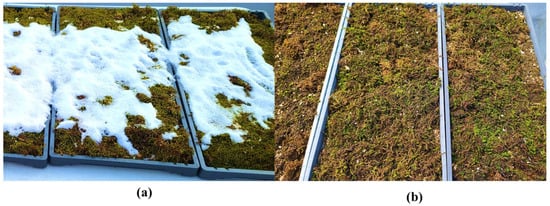
Figure 4.
Moss conditions during winter (a) and summer (b).
As shown in Figure 4, without an artificial water supply, the moss could survive both winter and summer. However, during summer, high temperatures and strong sunlight cause the partial scorching of mosses owing to insufficient water.
In addition, wild animals (e.g., birds) were observed to damage moss (Figure 5a), a problem that was also reported in another study using moss trays []. Under dry weather conditions with little rainfall, the bond between moss and soil weakened, allowing the moss and soil to be displaced by strong winds (Figure 5b). Conversely, during heavy rainfall, water accumulated in the trays, and when exposed to intense midday sunlight, the heated water damaged the moss tissues (Figure 5c).
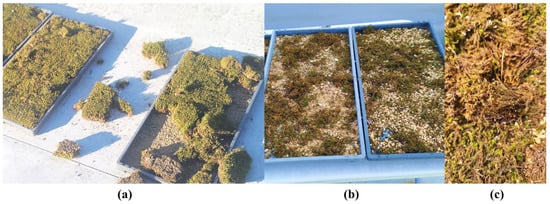
Figure 5.
Moss damage caused by (a) wild animals, (b) dry weather and strong winds, and (c) heavy rain combined with strong sunlight.
Consequently, the bare moss trays supplied by the manufacturer cannot be directly applied as green roofs in high-rise buildings. A properly constructed system is required to ensure structural and environmental suitability for moss-based applications. A protective net should be installed over the moss surface to mitigate the damage from wild animals and strong winds. The net should be sufficiently thin to minimize interference with moss growth. In addition, to maintain moss moisture while avoiding thermal stress, an automatic irrigation system should be implemented to supply the necessary amount of water.
3.2. Effect of Moss-Based Green Roof on Rooftop Temperature in the Second-Phase Experiment
The temperature mitigation effect of the moss-based green roof was investigated by comparing the bare roof surface temperature (RT) with the surface temperatures beneath the flat (FT-1) and sloped (ST-1) systems. Because daytime and nighttime temperatures differ substantially due to solar radiation, the comparisons are presented separately: daytime (07:00–18:00) in Figure 6 and nighttime (19:00–06:00) in Figure 7.

Figure 6.
Temperature variations on the bare roof surface and under flat and sloped moss-based systems during daytime in June (a), July (b), August (c) and September (d).
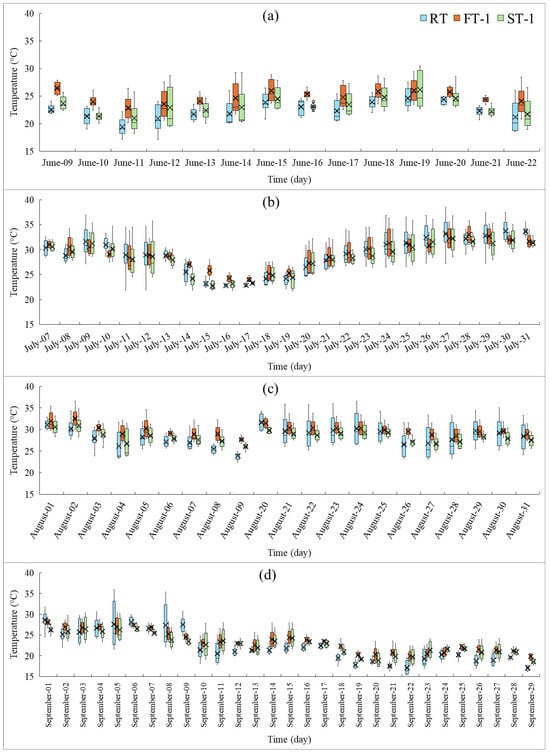
Figure 7.
Temperature variations on the bare roof surface and under flat and sloped moss-based systems at night in June (a), July (b), August (c) and September (d).
As shown in Figure 6, the bare roof temperatures (RTs) are significantly higher than those of the roofs coupled with both moss-based systems during summer (June–August), with the exception of several rainy days. When the weather transitioned to fall in September, the temperature difference between the bare and moss-covered roofs decreased. To statistically verify these differences, paired t-tests were performed (Tables S2 and S3, Supplementary Materials). As shown in Tables S2 and S3, the moss-based green roof significantly mitigated the rooftop surface temperatures during the daytime in all months (p < 0.001). The average temperature reduction ranged from approximately 3–8 °C, corresponding to large effect sizes (Cohen’s d = 0.80–1.31). These high t-values and small p-values provide strong statistical evidence that the temperature differences between the bare and moss-covered roofs were not due to random variations. Both the flat (FT-1) and sloped (ST-1) systems effectively lowered the roof temperatures, although the flat design showed a slightly stronger performance. The flat system achieved larger mean temperature differences (3.4–7.7 °C) and slightly higher effect sizes (mean d ≈ 0.9) than the sloped system (mean d ≈ 0.7). This can be attributed to the greater water retention and reduced convective heat loss in the flat configuration, because the sloped prototype had an open underside exposed to ambient air circulation. Nevertheless, in practical pitched-roof installations, this air gap would be minimized, making both systems comparably effective.
The RMSE and MNB results (Tables S3 and S4, Supplementary Materials) further supported these patterns. Daytime RMSE values (5.51–10.9 °C) and negative MNB values (−16.1% to −7.54%) confirmed consistent temperature reductions under both type systems.
This trend was consistent with the findings of previous studies. The effect of Sunagoke moss green roofs on temperature mitigation was investigated in an environmental chamber []. Under a light intensity of 1000 W/m2 with no wind, dry and wet moss reduced chamber temperatures by up to 10 °C and approximately 16 °C, respectively. When the wind speed was 3 m/s, the temperature reductions achieved by dry and wet moss were approximately 7 °C and 8 °C, respectively []. In another study, R. japonicum was used for a green roof installation composed of moss trays, measuring 10 m × 12 m on a school building. The results showed that the moss-based green roof reduced rooftop surface temperatures by up to 30 °C [].
It is worth noting that because the system was shaded during May to facilitate acclimation, the strong cooling observed in summer, particularly in July, likely reflects stabilized physiological activity and optimized evaporative capacity rather than immediate post-installation performance. Hence, the July results indicate the steady-state thermal behavior of mature moss canopies, rather than the transient response of newly transplanted mats. Similar acclimation periods have been reported for moss-based green roofs, during which moss tissues recover their photosynthetic capacity, re-establish capillary continuity, and stabilize water-retention dynamics before achieving full thermal functionality [,]. This suggests that incorporating a short acclimation or establishment phase is essential for optimizing the thermal performance of moss-based green roofs.
As shown in Figure 7, the average temperature on the bare roof is lower than that on the moss-covered roof. The statistical results (Tables S2 and S3) and the RMSE and MNB (Tables S4 and S5) strongly support this pattern. Consequently, temperatures under the moss-based systems were generally higher than those under the bare roof, confirming the heat retention and insulation functions of the moss layer. Most nighttime comparisons showed significant differences (p < 0.001), except in July and August (p > 0.05). These non-significant results suggest that, during warm and humid summer nights, the thermal contrast between the bare and moss-covered roofs could be reduced. Under such conditions, the radiative heat loss was naturally reduced, and both roof types remained at similar temperatures because of the elevated ambient air temperature and high humidity. The RMSE and MNB results in Tables S4 and S5 confirm these trends. Nighttime RMSE values (1.24–2.66 °C) and slightly positive MNB values demonstrated heat retention under the moss layer. Similar patterns were reported in other studies [,]. This is a key advantage of green roofs over cool roofs, which reflect more sunlight through specialized surface coatings. It was reported that, although both systems reduced the cooling energy demand of a building, only green roofs were effective in reducing the heating energy demand [,]. The mean annual cooling energy demand of buildings could decrease by approximately 70% and 85% in Cairo (a hot region) and Seoul (a cold region), respectively, when using green or cool roofs []. In contrast, green roofs could reduce annual heating energy consumption by approximately 30% in Seoul, whereas cool roofs could actually increase it by approximately 5% []. Therefore, green roofs are recommended to reduce the overall building energy demand, particularly in cold regions such as South Korea. However, green roofs are generally more sensitive to environmental conditions than cool roofs (e.g., broadleaf plants shed their leaves in winter) []. A moss-based green roof can overcome this limitation owing to the evergreen and resilient nature of moss. Overall, moss-based green roofs mitigated daytime heat and retained nighttime temperatures, contributing to reduced building energy consumption and alleviation of the urban heat island effect.
The prototype moss-based green roof could effectively reduce the rooftop temperature. However, this effect reflected the combined influence of the moss layer, soil, sand, and plastic panels. To evaluate the specific contribution of the moss layer, the temperatures at the moss surface and within the soil layer were compared (Figure 8).
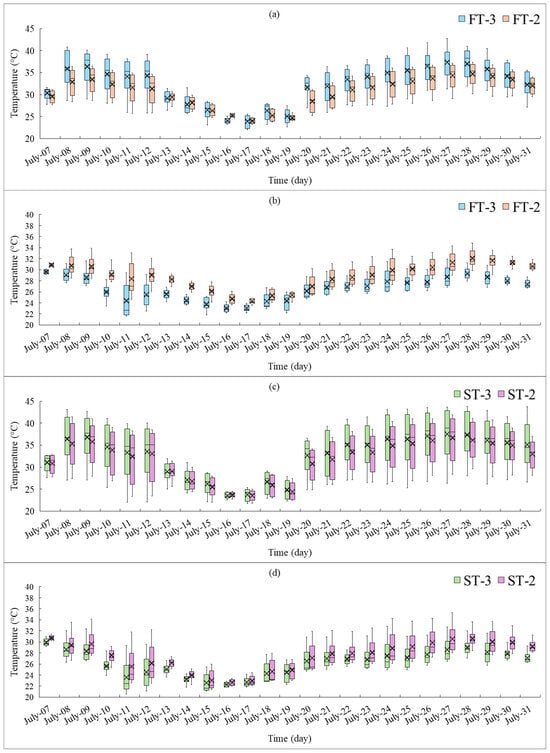
Figure 8.
Temperature variations in the moss and soil layers in July for (a) flat system, daytime; (b) flat system, nighttime; (c) sloped system, daytime; and (d) sloped system, nighttime.
As shown in Figure 8, the soil layer beneath the moss has significantly lower temperatures than the moss layer in both flat and sloped systems. A t-test confirmed a significant temperature difference between moss and soil at the 95% confidence level (all p-values < 0.05, Table 4). Effect sizes (0.5–0.58) indicate moderate practical cooling effect. This suggests that the moss layer reduced the impact of solar heating on the underlying soil.

Table 4.
Statistical values comparing the temperature of the moss layer and underlying soil layer in the moss-based green roof systems.
During daytime, the soil layer was cooler than the moss layer (i.e., negative MNB values in Table 4), with average differences of approximately 3 °C and 2 °C in the flat and sloped systems, respectively (Table 4). In contrast, at nighttime, the soil layer was warmer than the moss layer (i.e., positive MNB values in Table 4), with average differences of approximately 2.5 °C and 1.5 °C for the flat and sloped systems, respectively (Table 4). Thus, the moss layer helped buffer the soil temperature by reducing daytime heating and minimizing nighttime heat loss.
In addition, as shown in Table S6 (Supplementary Materials), the moss layer lowered roof temperatures during daytime by an average of 6–7 °C, with peak reductions reaching approximately 20 °C. RMSE values of 8–9 °C and negative MNB values confirm a consistent cooling bias relative to the bare surface. At nighttime, the temperature difference decreased to 2–3 °C. RMSE values of 3–4 °C and smaller MNB magnitudes indicate weaker but stable moderation. Flat and sloped configurations exhibited similar thermal performances, suggesting that roof geometry had minimal impact on the inherent temperature regulation of the moss layer. A previous study reported similar findings [], where moss alone reduced soil temperature by approximately 2.5 °C, and when combined with graminoids, by approximately 5 °C. Although mosses are thin and small, they have a high-water content and possess a strong evaporative capacity, which enables efficient evaporative cooling. Mosses possess an exceptionally high water-holding capacity. They can store 60–90% of their total water externally. Maximum water content can be over 5000% of dry weight, depending on species, largely due to external capillary storage and specialized hyaline cells [,]. However, they rapidly lose surface water through exponential decay within the first few hours of exposure, particularly under warm, dry, or windy conditions []. As water evaporates from the moss tissues, latent heat is removed from the surface, thereby lowering the roof temperature []. Moreover, the moss layer functions as a porous moisture-retaining medium that increases roof surface roughness. This enhances the airflow interaction at the roof surface, promotes convective heat transfer, and dissipates accumulated heat [].
However, the fixed 05:00/18:00 irrigation schedule likely enhanced daytime cooling by maximizing stored water prior to peak irradiance, which was consistent with the largest observed RT–FT-3 and RT–ST-3 temperature deltas near midday (Figure S1). Because the morning irrigation event preceded the daily peak by over 6 h, it did not artificially suppress ambient maxima but instead supplied water for latent heat removal as temperatures rose. The significant daytime reductions, indicated by large effect size (Tables S2 and S3) and negative MNB across months (Tables S4 and S5), indicated a consistent cooling bias independent of the fixed schedule.
The heat mitigation ability of the newly developed moss-based green roof was compared with that of conventional vegetated roof systems (Table 5). As shown in Table 5, the heat mitigation efficiency of green roofs varied widely depending on the vegetation type, local climate, and roof configuration. Sedum-based roofs, widely adopted in Mediterranean and subtropical regions such as Lisbon, Florianópolis, Cuernavaca, and Catania, typically reduced roof-surface temperature by 20–33 °C, with maximum cooling up to 30 °C under intense solar radiation. In temperate climates such as Liège and Melbourne, mixed grasses or sedum systems achieved more modest reductions of 1–11 °C, reflecting the milder ambient conditions and higher background humidity. In contrast, the moss-based green roof system developed in this study achieved roof-surface cooling of up to 20 °C at peak summer conditions in Seoul. Despite the thinner substrate and lower moss biomass compared with vascular plants, this performance was comparable to that of conventional systems. This strong performance arose from the high water-holding capacity of the moss, which allowed rapid surface evaporation once solar radiation increased.

Table 5.
Comparison of heat mitigation efficiency among green roofs.
In general, moss-based green roofs demonstrated effective daytime temperature mitigation and nighttime temperature retention. Despite their relatively small biomass compared to that of larger vegetation, the new moss exhibited a strong capacity for temperature regulation. Furthermore, the flat system exhibited better performance than the sloped system. This difference could be attributed to the empty space beneath the sloped prototype, which was influenced by the ambient air temperature and wind because the experiment was conducted on a flat roof. In actual pitched-roof applications, this empty space does not exist, and the performance difference between the systems is expected to be negligible.
3.3. Growth Characteristics of Moss Under Rooftop Conditions in the Second-Phase Experiment
Despite high summer temperatures, the new moss survived after 5 months (Figure 9).
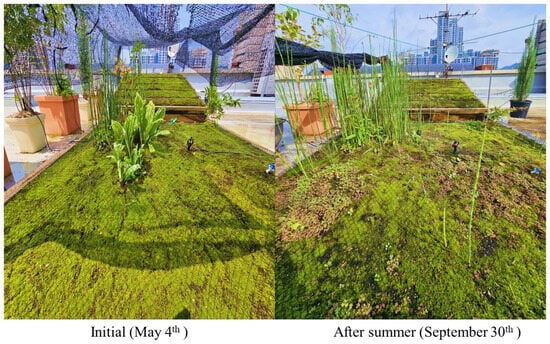
Figure 9.
Conditions of the moss-based green roof at different periods during the study.
As shown in Figure 9, the moss maintained a healthy green color after summer, even without shading. This finding is important for the CO2 capture capacity of moss, because green moss has the highest CO2 capture [].
To further evaluate moss growth, shoot length was measured once a month. The length variations and corresponding values are illustrated in Figure 10 and Figure 11, respectively.
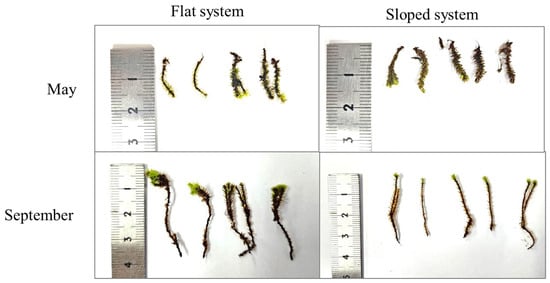
Figure 10.
Morphology of the moss at the initial stage and after 5 months of rooftop exposure.
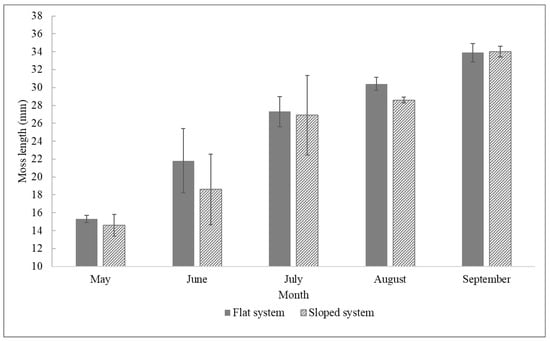
Figure 11.
Growth rates of mosses from May to September (error bars indicate standard deviation, number of samples = 3, replication = 5).
As shown in Figure 10, the mosses exhibit a significant increase in length, indicating healthy growth. The moss length increased steadily from May to July in both roof configurations, indicating successful establishment and active growth following installation. During this early period, the average moss growth rate reached approximately 5 mm per month. Growth then slowed from July to August (approximately 3 mm), likely because of high temperatures and strong sunlight in midsummer. This suggests that thermal and photic stress suppress photosynthetic activity and tissue elongation.
As shown in Figure 11, the flat-type system has a slightly higher moss length and growth rate than the sloped system during most months. This difference likely resulted from higher moisture retention on the flat surface, which maintained more stable hydration for photosynthesis and cell expansion. In contrast, a sloped-type system allows for faster surface drainage and more direct solar exposure, leading to greater desiccation stress during dry or hot days. However, the sloped-type system still supported continuous growth, confirming that the newly cultivated moss maintained its physiological resilience under both roof types. Consequently, these findings reinforce the suitability of this moss species for rooftop environments, where it can sustain measurable biomass production even under direct sunlight and high-temperature fluctuations.
With respect to carbon sequestration, monthly carbon mass was evaluated to determine growth patterns under varying environmental conditions (Figure 12).

Figure 12.
Variations in carbon mass with respect to moss length obtained from (a) flat-type system and (b) sloped-type system (error bars indicate standard deviation).
The carbon mass increased proportionally with moss length over time, indicating that carbon sequestration in moss biomass also increased during the study period (Figure 12). However, the relationship between carbon mass and moss length was better explained by a quadratic correlation than by a linear correlation. This could be attributed to the morphological changes observed in the moss (Figure 10); as time progressed, the moss length increased; however, the shoots became thinner than at the initial stage. This suggests that the rate of increase in length was lower than that of mass accumulation.
The carbon sequestration rate of the prototype system was estimated using the measured carbon mass and moss growth rates based on Equation (1). The estimation procedure is presented in Table S7. The results are summarized in Table 6.

Table 6.
Estimated carbon sequestration rate of the new moss used in the prototype systems.
As shown in Table 6, the carbon sequestration rate of the moss-based green roof in this study is approximately 0.3 kg C/m2.year. The sloped-type system exhibited a slightly higher rate than the flat-type system because it contained a greater number of moss individuals. This carbon sequestration rate was lower than that reported in a previous laboratory study (~0.52 kg C/m2.year) using newly cultivated strain of R. japonicum, Dozy and Molk, mosses []. This difference could be attributed to the experimental conditions. In a previous study, carbon sequestration was estimated from the CO2 capture rate measured in an environmental chamber over a short period, which was ideal for mosses to maximize their capture capacity. In contrast, under real rooftop conditions, multiple environmental factors, such as fluctuations in light intensity, daytime heating, and wind, might affect photosynthetic activity.
Nevertheless, the observed carbon sequestration of 0.3 kg C/m2.year was still significant and comparable to that of the other vegetation types, despite the relatively small moss biomass. A comparison with other studies is presented in Table 7.

Table 7.
Reported carbon sequestration rates of different plant species from various studies.
Consequently, moss-based green roofs using newly cultivated R. japonicum, Dozy, and Molk can be practically applied to building rooftops in urban areas to mitigate the urban heat island effect. The moss demonstrated strong adaptability and maintained its growth under high temperatures and intense sunlight without shading protection. In addition, moss-based green roofs can be classified as an extensive green roof type, which has a thinner substrate layer (2–20 cm) than intensive green roofs, resembling conventional ground-level gardens with substrate thicknesses exceeding 20 cm [,,]. Therefore, more extensive systems require less maintenance and irrigation. Furthermore, their lightweight structure, which ranges from 60–150 kg/m2 compared to 180–500 kg/m2 for intensive green roofs, helps reduce the structural load on buildings [,]. Moss-based green roofs generally host fewer arthropods than roofs planted with vascular species [], which can be advantageous for applications requiring low maintenance and reduced pest or allergen concerns (e.g., hospitals or school buildings) while still maintaining key environmental benefits such as cooling and stormwater retention. These characteristics highlight the key advantages of moss-based green roofs.
In general, a significant degree of surface cooling achieved by the moss-based green roofs of newly cultivated R. japonicum (Dozy and Molk) can substantially influence urban boundary-layer thermodynamics from an atmospheric perspective. Other studies reported neighborhood-scale air-temperature decreases of 0.5–2 °C, particularly during heatwaves, within a 30–150 m radius [,]. Similar results would be expected if moss-based systems were deployed across multiple buildings, given their comparable roof-surface cooling intensities. In parallel with thermal benefits, the moss-based system demonstrated a significant carbon sequestration rate. Although modest per unit area, this rate is comparable to that of low-biomass herbaceous systems. When scaled across large roof areas, it may represent a meaningful contribution to urban carbon budgets. In particular, the reduction in cooling-energy demand, which is associated with CO2 emissions from air-conditioning, provides an indirect carbon-mitigation pathway. Consequently, the combined thermal and carbon benefits of moss-based green roofs may extend beyond individual buildings to broader atmospheric and climate co-benefits, thereby supporting their role as integrated nature-based solutions for sustainable urban design.
This study has several limitations. First, the experimental green roof area was relatively small owing to funding constraints; thus, its impact on the indoor building temperature could not be evaluated. Second, seasonal effects were not fully assessed, although the influence of winter on moss growth was expected to be less critical than that of summer. Moreover, long-term investigation may help determine the risk of moss infections, such as those caused by fungal pathogens []. Third, the irrigation system was only partially automated and operated on a fixed schedule rather than through a fully controlled feedback system based on soil moisture. Hence, there is a lack of volumetric water content data for assessing the influence of irrigation on the cooling effect. Future work will incorporate volumetric water-content-triggered irrigation and test alternative irrigation methods (e.g., short, low-volume pulses) to quantify marginal cooling gains relative to water use. Fourth, although the moss showed stable growth during the five-month observation period, its long-term persistence without supplemental nutrients remains uncertain. Future studies should determine suitable fertilizer regimes to sustain the new moss over multiple years under rooftop environments. Finally, most studies on moss-based green roofs have been conducted in the Northern Hemisphere, particularly in Europe, North America, and East Asia (Table 1). This trend may be attributed to the fact that green roof technology originated and was industrialized in Germany and Northern Europe during the 1960s–1980s. These technological advancements have facilitated widespread adoption across Europe and North America, followed by expansion into East Asia []. Moreover, these regions have temperate or cool climates with moderate solar radiation and frequent rainfall, which are favorable conditions for moss survival. In contrast, the Southern Hemisphere, which includes Australia, New Zealand, and Chile, experiences higher solar irradiance, stronger UV exposure, and extended dry periods [], which can limit moss establishment and persistence. Consequently, research in the Southern Hemisphere has focused on succulents or native xerophytes for green roofs [,], leaving the feasibility of moss-based systems in warmer and drier climates unknown. Addressing this knowledge gap is essential for evaluating the global adaptability and resilience of moss-based green roofs in the context of future climate variability.
4. Conclusions
A prototype moss-based green roof using a newly cultivated strain of R. japonicum, Dozy and Molk, was developed to investigate rooftop performance and the feasibility of mitigating the urban heat island effect. Flat and sloped systems were constructed to represent flat and pitched roofs, and the experiment was conducted during the summer of 2025 under heatwave conditions.
The flat and sloped moss-based green roof prototypes effectively mitigated the rooftop surface temperature compared with the bare roof throughout summer. During daytime, the average roof temperature beneath the moss systems was approximately 6–10 °C lower than that of the bare roof, with maximum instantaneous reductions reaching 20 °C under peak solar radiation. At night, the moss-covered roofs retained up to approximately 2.5 °C higher average temperatures than the bare roof, indicating their additional role in reducing heat loss. Statistical analysis confirmed that these differences were significant with negative MNB values, further verifying the consistent cooling trends across all summer months. Consequently, moss-based green roofs using the new moss can provide substantial passive thermal regulation by reducing daytime heat accumulation and moderating nighttime heat release, thereby contributing to urban heat island mitigation and building energy savings.
When the configurations were compared, the flat system exhibited a slightly higher cooling efficiency than the sloped system. The sloped module exhibited slightly weaker cooling but maintained comparable thermal buffering, suggesting that both types are suitable for rooftop applications depending on the building design.
Despite direct exposure to high temperatures and intense sunlight, the moss grew steadily at approximately 3–5 mm per month. The annual carbon sequestration was estimated at approximately 0.3 kg C/m2.year, a value comparable to other vegetation under real-field conditions.
Future studies should evaluate the influence of moss-based green roofs on the indoor thermal regulation and building energy performance. Long-term monitoring across all seasons is also required to assess potential biotic stresses such as fungal infections and to better quantify annual carbon sequestration. Incorporating volumetric water-content sensors and moisture-controlled irrigation will allow a more precise analysis of the relationship between hydration dynamics and cooling performance. Fertilizer supplementation cycles should also be considered to prolong the lifetime of mosses. Furthermore, comparative studies in different climatic regions are recommended to evaluate the global applicability and resilience of moss-based green roofs under future climate scenarios.
Supplementary Materials
The following supporting information can be downloaded at: https://www.mdpi.com/article/10.3390/atmos16111277/s1, Table S1. Comparison of characteristics of Parkortanso No. 1 and wild Racomitrium japonicum (Dozy & Molk.). Table S2. Statistical comparison of temperatures between the bare roof (RT) and the roof coupled with a flat-type moss-based green roof (FT-1). Table S3. Statistical comparison of temperatures between the bare roof (RT) and the roof coupled with a sloped type moss-based green roof (ST-1). Table S4. RMSE and MNB for temperature comparison between the bare roof and the roof equipped with a flat-type moss-based green roof. Table S5. RMSE and MNB for temperature comparison between the bare roof and the roof equipped with a sloped-type moss-based green roof. Table S6. Statistical comparison of temperatures between the bare roof (RT) and temperature of the moss layer. Table S7. Carbon sequestration estimation procedure. Figure S1. Temperature differences between bare roof and moss-covered roof at daytime from July 8th to 12th.
Author Contributions
Conceptualization: J.-C.K., K.J. and T.-V.D.; Data acquisition: B.-G.P. and S.-W.L.; Data analysis: S.K. and S.-W.L.; Visualization: B.-G.P., K.J. and S.K.; Writing—Original Draft Preparation: S.K. and T.-V.D.; Writing—Review and Editing: H.C. and J.-C.K. All authors have read and agreed to the published version of the manuscript.
Funding
This research received no external funding.
Institutional Review Board Statement
Not applicable.
Informed Consent Statement
Not applicable.
Data Availability Statement
Data are contained within the article. More detailed data are available from the corresponding authors upon reasonable request.
Acknowledgments
This work was supported by the Citizens’ Committee for Green Seoul. This work was supported by the Indoor Environmental Management Center, Konkuk University.
Conflicts of Interest
The authors declare no conflicts of interest.
References
- Gago, E.J.; Roldan, J.; Pacheco-Torres, R.; Ordóñez, J. The City and Urban Heat Islands: A Review of Strategies to Mitigate Adverse Effects. Renew. Sustain. Energy Rev. 2013, 25, 749–758. [Google Scholar] [CrossRef]
- Kolokotroni, M.; Zhang, Y.; Watkins, R. The London Heat Island and Building Cooling Design. Sol. Energy 2007, 81, 102–110. [Google Scholar] [CrossRef]
- Santamouris, M.; Papanikolaou, N.; Livada, I.; Koronakis, I.; Georgakis, C.; Argiriou, A.; Assimakopoulos, D.N. On the Impact of Urban Climate on the Energy Consumption of Buildings. Sol. Energy 2001, 70, 201–216. [Google Scholar] [CrossRef]
- Shafique, M.; Kim, R.; Rafiq, M. Green Roof Benefits, Opportunities and Challenges—A Review. Renew. Sustain. Energy Rev. 2018, 90, 757–773. [Google Scholar] [CrossRef]
- Heim, A.; Lundholm, J.; Philip, L. The Impact of Mosses on the Growth of Neighbouring Vascular Plants, Substrate Temperature and Evapotranspiration on an Extensive Green Roof. Urban Ecosyst. 2014, 17, 1119–1133. [Google Scholar] [CrossRef]
- Drake, P.; Grimshaw-Surette, H.; Heim, A.; Lundholm, J. Mosses Inhibit Germination of Vascular Plants on an Extensive Green Roof. Ecol. Eng. 2018, 117, 111–114. [Google Scholar] [CrossRef]
- Nagase, A.; Katagiri, T.; Lundholm, J. Investigation of Moss Species Selection and Substrate for Extensive Green Roofs. Ecol. Eng. 2023, 189, 106899. [Google Scholar] [CrossRef]
- Choi, J. Evaluation of the Temperature-Reduction Effects of Moss-Based Green Roofs. SSRN Electron. J. 2025, 5495640. [Google Scholar] [CrossRef]
- Marttinen, E.M.; Niemi-Kapee, J.; Laaka-Lindberg, S.; Valkonen, J.P.T. Fungal Pathogens Infecting Moss Green Roofs in Finland. Urban For. Urban Green. 2020, 55, 126812. [Google Scholar] [CrossRef]
- Bengtsson, L. Peak Flows from Thin Sedum-Moss Roof. Hydrol. Res. 2005, 36, 269–280. [Google Scholar] [CrossRef]
- Gabrych, M.; Kotze, D.J.; Lehvävirta, S. Substrate Depth and Roof Age Strongly Affect Plant Abundances on Sedum-Moss and Meadow Green Roofs in Helsinki, Finland. Ecol. Eng. 2016, 86, 95–104. [Google Scholar] [CrossRef]
- Van Dijck, T.; Klerkx, H.; Thijs, S.; Rineau, F.; Van Mechelen, C.; Artois, T. Sedum as Host Plants for Caterpillars? Introducing Gut Content Metabarcoding to Green Roof Research. Urban Ecosyst. 2023, 26, 955–965. [Google Scholar] [CrossRef]
- Heim, A.; Kunle, M.; Chagnon, P.L.; Lehvävirta, S.; Buffam, I. Trait-Environment Relationships over Short Taxonomic and Abiotic Gradients on Sedum/Moss Roofs. Urban For. Urban Green. 2025, 112, 128915. [Google Scholar] [CrossRef]
- Anderson, M.; Lambrinos, J.; Schroll, E. The Potential Value of Mosses for Stormwater Management in Urban Environments. Urban Ecosyst. 2010, 13, 319–332. [Google Scholar] [CrossRef]
- Eldridge, D.J.; Guirado, E.; Reich, P.B.; Ochoa-Hueso, R.; Berdugo, M.; Sáez-Sandino, T.; Blanco-Pastor, J.L.; Tedersoo, L.; Plaza, C.; Ding, J.; et al. The Global Contribution of Soil Mosses to Ecosystem Services. Nat. Geosci. 2023, 16, 430–438. [Google Scholar] [CrossRef]
- Seo, Y.-B.; Dinh, T.-V.; Kim, S.; Baek, D.-H.; Jung, K.; Kim, J.-C. CO2 Removal Characteristics of a Novel Type of Moss and Its Potential for Urban Green Roof Applications. Asian J. Atmos. Environ. 2023, 17, 22. [Google Scholar] [CrossRef]
- Perini, K.; Castellari, P.; Calbi, M.; Prandi, S.; Roccotiello, E. Fine Dust Collection Capacity of a Moss Greening System for the Building Envelope: An Experimental Approach. Build. Environ. 2025, 267, 112203. [Google Scholar] [CrossRef]
- Gong, G.Y.; Kang, J.S.; Jeong, K.J.; Jeong, J.H.; Yun, J.G. Effect of Several Native Moss Plants on Particulate Matter, Volatile Organic Compounds and Air Composition. J. People Plants Environ. 2019, 22, 31–38. [Google Scholar] [CrossRef]
- Basiliko, N.; Knowles, R.; Moore, T.R. Roles of Moss Species and Habitat in Methane Consumption Potential in a Northern Peatland; The Society of Wetland Scientists: Washington, DC, USA, 2004; Volume 24. [Google Scholar]
- Kox, M.A.R.; Smolders, A.J.P.; Speth, D.R.; Lamers, L.P.M.; Op den Camp, H.J.M.; Jetten, M.S.M.; van Kessel, M.A.H.J. A Novel Laboratory-Scale Mesocosm Setup to Study Methane Emission Mitigation by Sphagnum Mosses and Associated Methanotrophs. Front. Microbiol. 2021, 12, 652486. [Google Scholar] [CrossRef]
- Campos, M.L.; Prado, G.S.; dos Santos, V.O.; Nascimento, L.C.; Dohms, S.M.; da Cunha, N.B.; Ramada, M.H.S.; Grossi-de-Sa, M.F.; Dias, S.C. Mosses: Versatile Plants for Biotechnological Applications. Biotechnol. Adv. 2020, 41, 107533. [Google Scholar] [CrossRef]
- Madre, F.; Vergnes, A.; Machon, N.; Clergeau, P. A Comparison of 3 Types of Green Roof as Habitats for Arthropods. Ecol. Eng. 2013, 57, 109–117. [Google Scholar] [CrossRef]
- Perini, K.; Castellari, P.; Gisotti, D.; Giachetta, A.; Turcato, C.; Roccotiello, E. MosSkin: A Moss-Based Lightweight Building System. Build. Environ. 2022, 221, 109283. [Google Scholar] [CrossRef]
- Seoul Metropolitan Goverment Seoul City Overview. Available online: https://english.seoul.go.kr/seoul-views/meaning-of-seoul/3-climate/ (accessed on 21 October 2025).
- Korea Meteorological Administration Korean Climate Characteristics. Available online: https://www.weather.go.kr/w/climate/statistics/korea-char.do (accessed on 21 October 2025).
- Ayres, E.; Van Der Wal, R.; Sommerkorn, M.; Bardgett, R.D. Direct Uptake of Soil Nitrogen by Mosses. Biol. Lett. 2006, 2, 286–288. [Google Scholar] [CrossRef]
- Geun, W.; Ho, J.; Cheol, Y. Characteristics of External Pressure Coefficient on Low-Rise Buildings with Various Roof Slopes; 2009, Volume 13, pp. 57–66. Available online: https://www.kci.go.kr/kciportal/ci/sereArticleSearch/ciSereArtiView.kci?sereArticleSearchBean.artiId=ART001374359 (accessed on 15 September 2025).
- Getter, K.L.; Rowe, D.B.; Andresen, J.A. Quantifying the Effect of Slope on Extensive Green Roof Stormwater Retention. Ecol. Eng. 2007, 31, 225–231. [Google Scholar] [CrossRef]
- Wang, Z.; Bader, M.Y. Associations between Shoot-Level Water Relations and Photosynthetic Responses to Water and Light in 12 Moss Species. AoB Plants 2018, 10, ply034. [Google Scholar] [CrossRef]
- Coelho, M.C.M.; Gabriel, R.; Ah-Peng, C. Characterizing and Quantifying Water Content in 14 Species of Bryophytes Present in Azorean Native Vegetation. Diversity 2023, 15, 295. [Google Scholar] [CrossRef]
- Haughian, S.R.; Lundholm, J.L. Mosses for Minimalist Green Roofs: A Preliminary Study of the Effects of Rooftop Exposure, Species Selection, and Lab-Grown vs. Wild-Harvested Propagule Sources. Nat. Based Solut. 2024, 5, 100119. [Google Scholar] [CrossRef]
- Korea Meteorological Administration Korea Weather Database. Available online: https://www.kma.go.kr/neng/index.do (accessed on 2 October 2025).
- Baek, D.-H.; Seo, Y.-B.; Yu, S.-J.; Choi, I.-Y.; Lee, S.-W.; Son, Y.-S.; Dinh, T.-V.; Kim, J.-C. Comparison of Biogenic Volatile Organic Compounds Emissions from Representative Urban Tree Species in South Korea and Evaluation of Standard Emission Rate Models. Atmos. Environ. 2024, 333, 120654. [Google Scholar] [CrossRef]
- Aydin, Y.M.; Yaman, B.; Koca, H.; Dasdemir, O.; Kara, M.; Altiok, H.; Dumanoglu, Y.; Bayram, A.; Tolunay, D.; Odabasi, M.; et al. Biogenic Volatile Organic Compound (BVOC) Emissions from Forested Areas in Turkey: Determination of Specific Emission Rates for Thirty-One Tree Species. Sci. Total Environ. 2014, 490, 239–253. [Google Scholar] [CrossRef]
- K, M.A.A.; Katoh, Y.; Katsurayama, H.; Koganei, M.; Mizunuma, M. Effects of Convection Heat Transfer on Sunagoke Moss Green Roof: A Laboratory Study. Energy Build. 2018, 158, 1417–1428. [Google Scholar] [CrossRef]
- Jia, S.; Weng, Q.; Yoo, C.; Xiao, H.; Zhong, Q. Building Energy Savings by Green Roofs and Cool Roofs in Current and Future Climates. npj Urban Sustain. 2024, 4, 23. [Google Scholar] [CrossRef]
- Zhao, S.; Hai, G.; Ma, H.; Zhang, X. Experimental Analysis of Energy Consumption of Building Roof Energy-Saving Technologies Based on Time Difference Comparison Test. Front. Energy Res. 2023, 11, 1291213. [Google Scholar] [CrossRef]
- Joshi, M.Y.; Rodler, A.; Musy, M.; Guernouti, S.; Teller, J. Influence of Urban Morphology on Potential of Green Roofs in Regulating Local Microclimate: A Case Study of Liège, Belgium. Urban Clim. 2024, 58, 102144. [Google Scholar] [CrossRef]
- Imran, H.M.; Kala, J.; Ng, A.W.M.; Muthukumaran, S. Effectiveness of Green and Cool Roofs in Mitigating Urban Heat Island Effects during a Heatwave Event in the City of Melbourne in Southeast Australia. J. Clean. Prod. 2018, 197, 393–405. [Google Scholar] [CrossRef]
- Piccinini Scolaro, T.; Ghisi, E.; Silva, C.M. Assessing the Impact of Evapotranspiration from Green Roofs on Reducing Surface Temperatures. J. Build. Eng. 2024, 95, 110095. [Google Scholar] [CrossRef]
- Chagolla-Aranda, M.A.; Simá, E.; Xamán, J.; Álvarez, G.; Hernández-Pérez, I.; Téllez-Velázquez, E. Effect of Irrigation on the Experimental Thermal Performance of a Green Roof in a Semi-Warm Climate in Mexico. Energy Build. 2017, 154, 232–243. [Google Scholar] [CrossRef]
- Cascone, S.; Gagliano, A.; Poli, T.; Sciuto, G. Thermal Performance Assessment of Extensive Green Roofs Investigating Realistic Vegetation-Substrate Configurations. Build. Simul. 2019, 12, 379–393. [Google Scholar] [CrossRef]
- Kim, Y.; Kodama, Y.; Shim, C.; Kushida, K. Carbon Exchange Rates in Polytrichum Juniperinum Moss of Burned Black Spruce Forest in Interior Alaska. Polar Sci. 2014, 8, 146–155. [Google Scholar] [CrossRef]
- Riis, T.; Christoffersen, K.S.; Baattrup-Pedersen, A. Mosses in High-Arctic Lakes: In Situ Measurements of Annual Primary Production and Decomposition. Polar Biol. 2016, 39, 543–552. [Google Scholar] [CrossRef]
- Gerdol, R.; Bragazza, L.; Marchesini, R. Element Concentrations in the Forest Moss Hylocomium Splendens: Variation Associated with Altitude, Net Primary Production and Soil Chemistry. Environ. Pollut. 2002, 116, 129–135. [Google Scholar] [CrossRef] [PubMed]
- Lagergren, F.; Lindroth, A.; Dellwik, E.; Ibrom, A.; Lankreijer, H.; Launiainen, S.; Mölder, M.; Kolari, P.; Pilegaard, K.; Vesala, T. Biophysical Controls on CO2 Fluxes of Three Northern Forests Based on Long-Term Eddy Covariance Data. Tellus B 2008, 60, 143–152. [Google Scholar] [CrossRef]
- Zha, T.S.; Barr, A.G.; Bernier, P.-Y.; Lavigne, M.B.; Trofymow, J.A.; Amiro, B.D.; Arain, M.A.; Bhatti, J.S.; Black, T.A.; Margolis, H.A.; et al. Gross and Aboveground Net Primary Production at Canadian Forest Carbon Flux Sites. Agric. For. Meteorol. 2013, 174–175, 54–64. [Google Scholar] [CrossRef]
- Mora-Melià, D.; López-Aburto, C.; Ballesteros-Pérez, P.; Muñoz-Velasco, P. Viability of Green Roofs as a Flood Mitigation Element in the Central Region of Chile. Sustainability 2018, 10, 1130. [Google Scholar] [CrossRef]
- Reyes, R.; Bustamante, W.; Gironás, J.; Pastén, P.A.; Rojas, V.; Suárez, F.; Vera, S.; Victorero, F.; Bonilla, C.A. Effect of Substrate Depth and Roof Layers on Green Roof Temperature and Water Requirements in a Semi-Arid Climate. Ecol. Eng. 2016, 97, 624–632. [Google Scholar] [CrossRef]
- Oberndorfer, E.; Lundholm, J.; Bass, B.; Coffman, R.R.; Doshi, H.; Dunnett, N.; Gaffin, S.; Köhler, M.; Liu, K.K.Y.; Rowe, B. Green Roofs as Urban Ecosystems: Ecological Structures, Functions, and Services. Bioscience 2007, 57, 823–833. [Google Scholar] [CrossRef]
- Jamei, E.; Chau, H.W.; Seyedmahmoudian, M.; Mekhilef, S.; Hafez, F.S. Green Roof and Energy—Role of Climate and Design Elements in Hot and Temperate Climates. Heliyon 2023, 9, e15917. [Google Scholar] [CrossRef] [PubMed]
- Dong, J.; Lin, M.; Zuo, J.; Lin, T.; Liu, J.; Sun, C.; Luo, J. Quantitative Study on the Cooling Effect of Green Roofs in a High-Density Urban Area—A Case Study of Xiamen, China. J. Clean. Prod. 2020, 255, 120152. [Google Scholar] [CrossRef]
- Akita, M.; Lehtonen, M.T.; Koponen, H.; Marttinen, E.M.; Valkonen, J.P.T. Infection of the Sunagoke Moss Panels with Fungal Pathogens Hampers Sustainable Greening in Urban Environments. Sci. Total Environ. 2011, 409, 3166–3173. [Google Scholar] [CrossRef]
- Magill, J.D.; Midden, K.; Groninger, J.; Therrell, M. History and Definition of Green Roof Technology with Recommendations for Future Research; Southern Illinois University Carbondale: Carbondale, IL, USA, 2011. [Google Scholar]
- Cordero, R.R.; Feron, S.; Damiani, A.; Sepúlveda, E.; Jorquera, J.; Redondas, A.; Seckmeyer, G.; Carrasco, J.; Rowe, P.; Ouyang, Z. Surface Solar Extremes in the Most Irradiated Region on Earth, Altiplano. Bull. Am. Meteorol. Soc. 2023, 104, E1206–E1221. [Google Scholar] [CrossRef]
- Irga, P.J.; Fleck, R.; Arsenteva, E.; Torpy, F.R. Biosolar Green Roofs and Ambient Air Pollution in City Centres: Mixed Results. Build. Environ. 2022, 226, 109712. [Google Scholar] [CrossRef]
- Fleck, R.; Westerhausen, M.T.; Killingsworth, N.; Ball, J.; Torpy, F.R.; Irga, P.J. The Hydrological Performance of a Green Roof in Sydney, Australia: A Tale of Two Towers. Build. Environ. 2022, 221, 109274. [Google Scholar] [CrossRef]
Disclaimer/Publisher’s Note: The statements, opinions and data contained in all publications are solely those of the individual author(s) and contributor(s) and not of MDPI and/or the editor(s). MDPI and/or the editor(s) disclaim responsibility for any injury to people or property resulting from any ideas, methods, instructions or products referred to in the content. |
© 2025 by the authors. Licensee MDPI, Basel, Switzerland. This article is an open access article distributed under the terms and conditions of the Creative Commons Attribution (CC BY) license (https://creativecommons.org/licenses/by/4.0/).